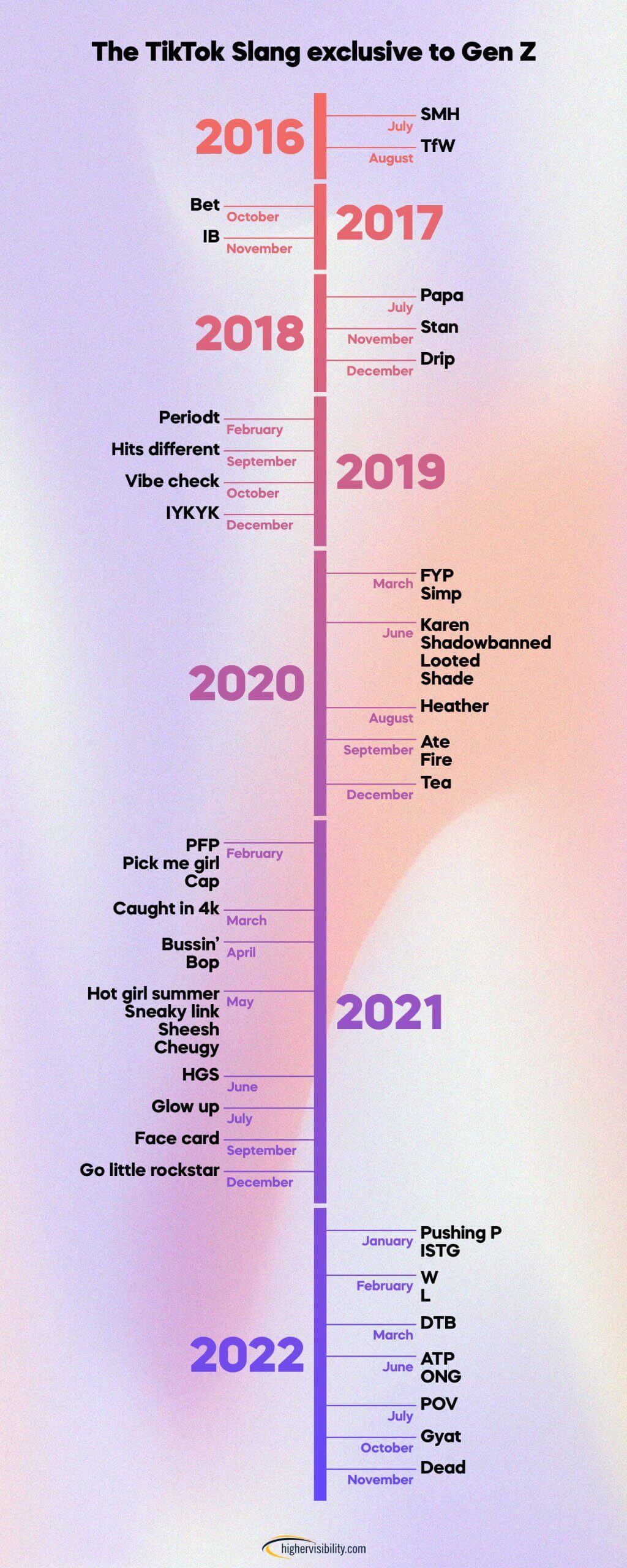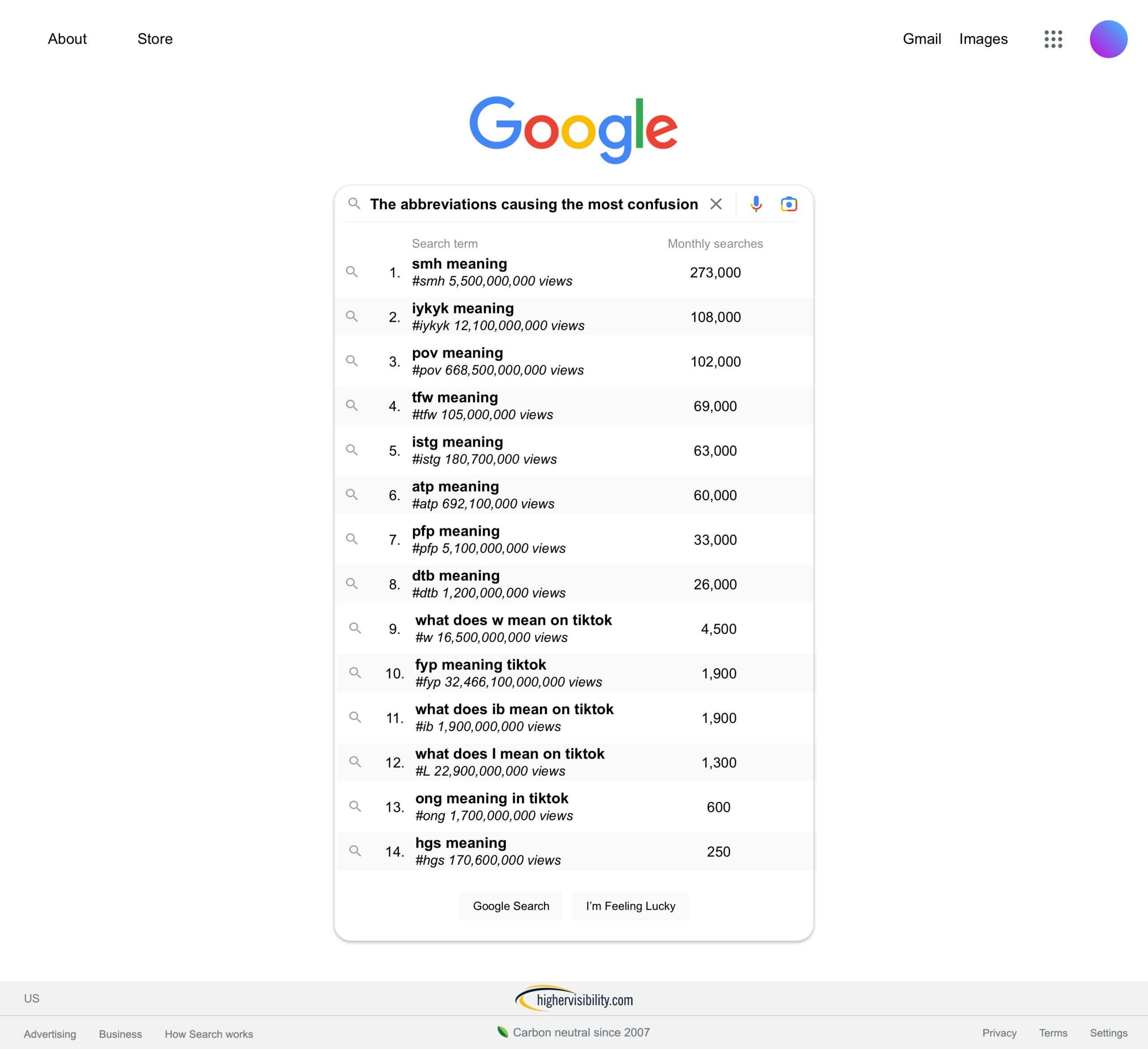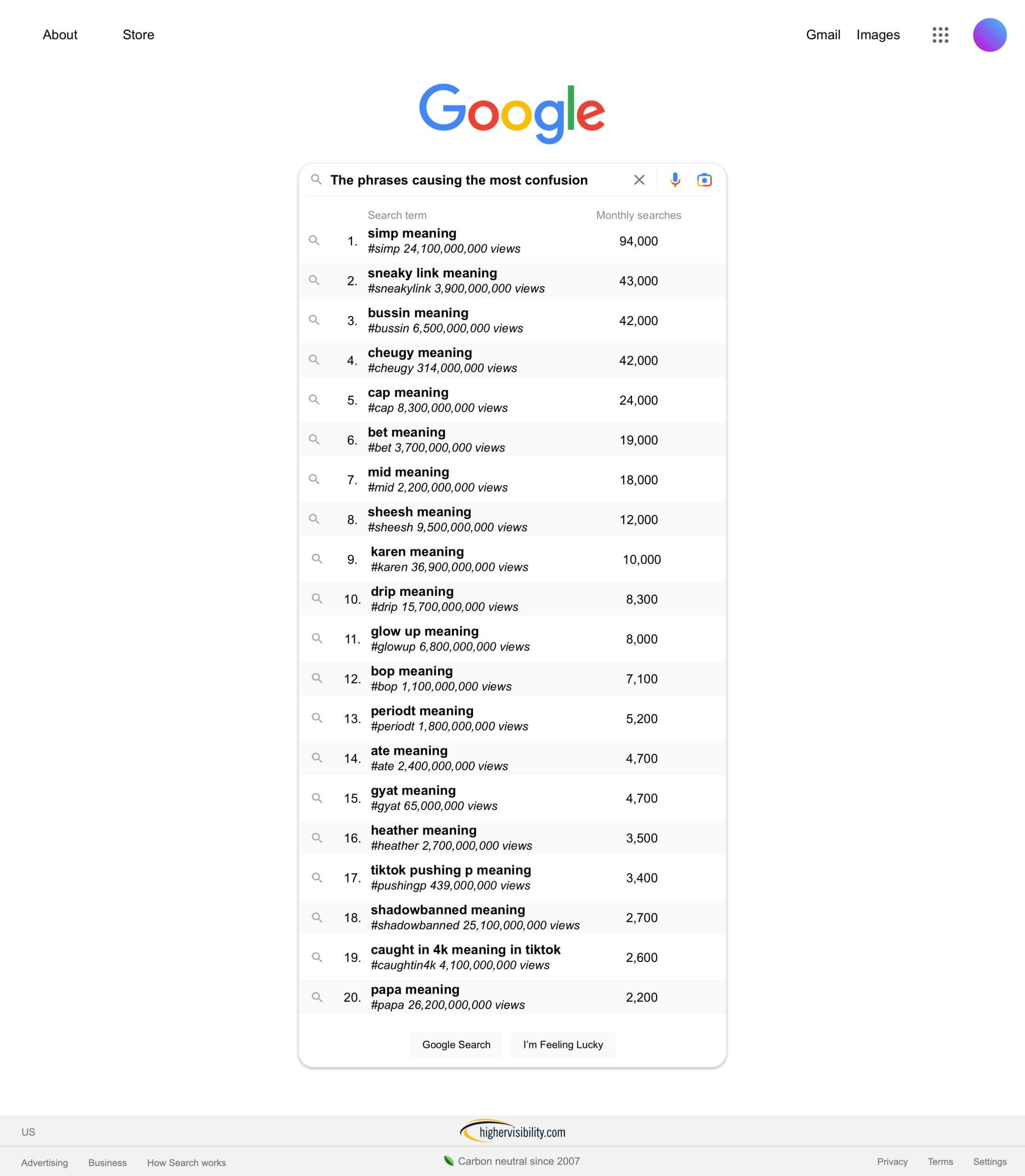TikTok Slang: The Exclusive Language of Gen Z
Will those unfamiliar with the platform be left behind and, ultimately, out of the conversation?
Slang has provided an alternate, coded means of communication for years. However, the rise of the social media platform TikTok has compounded this effect, generating new words exclusive to Gen Z and reinventing the meaning and usage of existing slang. In many cases, the language used on TikTok is exclusive, resulting in people outside the platform struggling with the true meaning. Even phrases that seem familiar, like ‘POV’ or being ‘the CEO’ of something, are used differently due to the social media platform.
As such, HigherVisibility has taken a seed list of some of the most popular TikTok slang phrases and abbreviations, using Google search volume and Google Trends to create a timeline of when these words came back into circulation within the dates of TikTok’s launch or became popular for the first time. We’ve also analyzed the abbreviations and phrases as TikTok hashtags to compare their in-app popularity with search volume, particularly of terms relating to the meaning of the word or phrase.
An example conversation using TikTok slang:
- “POV: you’ve got all the latest Gucci drip, life’s good”
- “Ewww no, some of Gucci’s latest drops have been cheugy, SMH”
- “Alright bet, everything on my FYP has been fire.”
- “You’re capping, everything I’ve seen has been mid at best.”
Social media increasingly affects consumer behavior, with large numbers of younger people using TikTok as a search engine for everything from clothes, holiday destinations, and restaurant recommendations rather than Google. Therefore it is becoming increasingly important to understand the language used by the generation that spends time there and carries out essential tasks like shopping there.

Research shows that 8 new users join TikTok every second, with an average of 650,000 new users joining daily. Our study shows that based on the seed list of slang, the number of terms ramped up between 2020 and 2022, in line with TikTok’s growth as a platform. As of 2019, TikTok users were at 507,552,660, but by 2021 they reached the milestone of 1,000,000,000 users. The slang that we studied peaked in 2021, with 15 slang terms and abbreviations becoming widely popular that year.
However, our research also showed that many of these words caused confusion, whether it was users in the app Googling to discover the meaning of these new terms appearing or those outside of the platform that had seen these used elsewhere.

Coming in at the top was an abbreviation that didn’t originate on the platform itself; however, continues to baffle people when they see it. SMH, meaning ‘shake my head’ is used to express disappointment in someone or something. When cross-referenced with Urban Dictionary, it’s clear this abbreviation has been around for some time, with users providing definitions as early as 2004. The first peak for this abbreviation (during the availability of TikTok as a platform) was in July 2016. The word continues to average 273,000 searches monthly, showing that it is still commonly used and not yet widely understood. Several people dispute the meaning of ‘so much hate’ rather than ‘shake my head’ or ‘shaking my head’, showing that it continues to perplex people.
There’s a rising trend toward creating posts that involve the viewer on a personal level, as can be seen from the popularity of using ‘IYKYK’ and videos involving ‘POV’ or ‘TFW’. ‘IYKYK,’ a shortened version of ‘if you know, you know,’ was the second highest search query when it came to people asking Google for its meaning. Primarily used on TikTok but also across other platforms, the expression creates the feel of an inside joke or an experience limited to only those who ‘know’, creating more of a connection or sense of community between the creator and viewer. The phrase was only defined by users on Urban Dictionary in around 2016.
Meanwhile, POV has definitions in Urban Dictionary as early as 2005; however, TikTok has largely transformed the usage and frequency of the term. POV TikTok videos place you within a situation, for example, ‘POV: you’re on the phone with your nosy aunt’, where the TikToker would make you feel as though you’re actually on the call. TFW refers to the phrase ‘that feeling when’, which refers to an event and how that may make someone feel. For example, ‘tfw someone takes food from your plate’, which has Urban Dictionary entries that predate TikTok. However, like the term POV, these terms have shot up in renewed popularity due to trending video formats on the platform.

Gen Z is often criticized for its attitude towards love, commitments, and partnerships. According to TikTok hashtag views, the slang term ‘simp’ is in the top 5 most popular, with 24.1 million views as of November 2022; it’s also the number one most searched slang term meaning on Google from our list with an average monthly search volume of 94,000. While this term originally had a stronger meaning, it’s often thrown around to refer to someone that will do excessively nice things for their crush to win their affection and typically not get them in the end. Often, their crush will have expressed disinterest; however, they continue to shower them with affection to win them over. This perhaps suggests embarrassment over ‘doing too much’ to attract someone for Gen Zs, with the age of wooing someone officially over.
The second term, ‘sneaky link’ originated on TikTok but has found its way to other platforms; it refers to seeing someone, usually in a romantic way, without letting anyone know. When cross-referenced with Urban Dictionary, most user-added definitions are newer, ranging from 2020 onwards. The fact that the two highest-ranking search queries regarding the meaning of these slang phrases were ‘simp’ and ‘sneaky link’ could suggest a disparity between generational views of love and relationships.
The third term, ‘bussin’, isn’t exclusive to TikTok, nor did it originate there. The term refers to something extremely good. However, there are entries in Urban Dictionary as early as 2006 defining it. But, for the most part, TikTok videos have repopularised the term, particularly in food-related videos.
TikTok has also garnered quite the following regarding content creators on style, with increasingly niche terms to describe the vibe of items of clothing, such as ‘coastal grandmother’ and ‘barbiecore’ becoming popular. There’s also a sense of generational conflict when it comes to styles such as ‘jeggings’ and ‘skinny jeans’, as well as a term to reflect it. Describing something as ‘cheugy’ means being out of date or trying too hard, usually relating to something once popular but no longer and people following those out-of-date styles. All urban dictionary entries refer to recent years, primarily past 2020, showing the rise of this as a concept being popularised by the platform.
In the fifth position is ‘cap’, which is essentially another word for lying, and can be used in several different ways, for example, ‘that’s cap,’ e.g. that’s a lie or ‘no cap’- I’m not lying/overexaggerating. When cross-referenced with Urban Dictionary, early definitions added by users didn’t match the newer references that have been popularised by TikTok, showing that usage on the platform has altered the meaning.
Despite their meaning not being as frequently searched and not being exclusive to TikTok, terms like ‘Karen’ are significant in showing the dominant culture on social media and marking subcultures and attitudes that are deeper than shortened versions of words and throwaway slang. This archetype has existed in multiple different references; however typically refers to an angry, entitled, and often racist white woman. The peak in search queries relating to June 2020 follows the murder of George Floyd and the heightened tensions of the coronavirus pandemic and people policing other people’s behaviors. Slang terms like this have developed online to the extent that they can be pinpointed through timelines and exact videos, with the usage that has been perpetuated through platforms like TikTok.
Language, particularly slang, offers a unique insight that allows us to understand different groups at a core level. From attitudes towards commitment and relationships to deeper instances of a generation calling out unacceptable behavior, the language of TikTok offers us an unparalleled glance into the attitudes of Gen Z. This coded language unites digital communities while also excluding those that are outside of the platform to the extent that it can seem like another language in and of itself. TikTok is set to skyrocket over the next couple of years, and from this study, we can learn that language will evolve with it. Given the significance of this language, it’s vital that those that wish to understand this generation keep up with the lingo they use to express themselves.
——————————————————————————————————————————
Methodology
HigherVisibility created a seed list of popular abbreviations and slang on TikTok, analyzing the hashtag views of this term within the platform and comparing that with US Google search queries for ‘term + meaning’ to discover which of these are causing the most confusion. We analyzed Google Trends to find the months where the searches for these terms peaked to create a timeline, then cross-referenced this with Urban Dictionary to show the history of these terms and how they have evolved in usage through TikTok.
